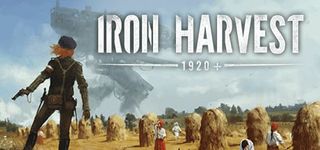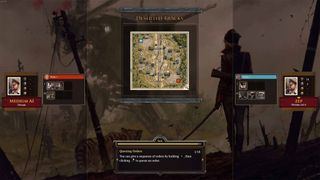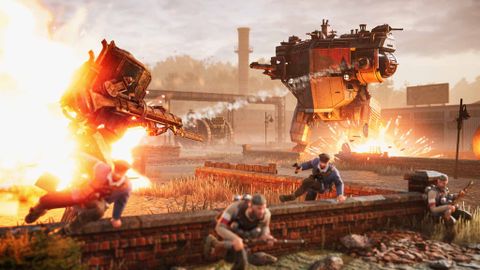Iron Harvest, developed by KING Art Games and published by Deep Silver, has arrived in all its steaming mechanical glory for a 1.0 release after years of work. This real-time strategy (RTS) game blends alternate post-WWI history with tactical gameplay, all set in a world created by artist Jakub Różalski. This "1920+" timeline is compelling, offering up unique characters and heroes as they live in a war-filled reality dominated by enormous mechs that make short work of the infantry of this era. I previewed Iron Harvest almost six months ago, noting that there was still some work to be done. Does it live up to the hype now that it's been fully released?

Bottom line: Iron Harvest offers a strong, story-driven campaign split into three interwoven parts. However, its core RTS mechanics leave something to be desired, and some common RTS features are lacking or missing. The good news is that the developers are still hard at work improving Iron Harvest, tweaking mechanics and adding content.
For
- Lengthy story-driven campaign
- Inspired artwork and models
- Skirmishes are quick fun
- Pleasant graphics
- Stellar map design
Against
- Unit pathfinding and movement issues
- Odd AI behavior at times
- Some bugs and performance woes
What's it like to play Iron Harvest?
| Category | Spec |
|---|---|
| Developer | KING Art Games |
| Publisher | Deep Silver |
| Genre | Real-time strategy |
| Rating | Mature |
| Platform | Windows 10 |
| Recommended | 8th Gen Intel Core i7 (or AMD equivalent) 16GB RAM NVIDIA RTX 2060 (or AMD equivalent) |
Iron Harvest clearly takes inspiration from popular RTS games of our past, including Company of Heroes and its sequels. Most solid items on the map can be used for cover by infantry — green or yellow dots show up when moving units — and intact buildings can be occupied for extra cover and to act as a firebase. Nearly everything can be destroyed in spectacular fashion, adding an extra layer to the game once large mechs hit the field. Units can be ordered to move in reverse to protect weak spots, units can retreat back to base with faster movement speed, and they can be suppressed by heavy fire. For a modern touch, multiple orders can be queued so that you can focus elsewhere while units take care of a few commands in a row.
When you're not playing the campaign's preset missions (which have their own share of base building and resource capturing), singleplayer and multiplayer skirmishes have a strong focus on map control and victory point acquisition. Tactical play is far more important than a booming economy and en-masse unit production. It's a big difference from something like my personal RTS favorite, Age of Empires II: Definitive Edition, and that's OK. You still need to protect iron and oil mines that you've built up, which often isn't as easy as it seems if your army is mostly made up of slow mechs chasing down fast infantry.
If you're a fan of Company of Heroes and its sequels, Iron Harvest is going to immediately feel familiar.
There are three main buildings that engineers can construct; Headquarters, Workshop, and Barracks. These pump out heroes, infantry, weapon systems, and mechs, and they can be upgraded to allow access to stronger units. Each team has a standard set of riflemen, explosive gunners, machine gunners, grenadiers, flamethrowers, medics, and engineers (some with slightly different names depending on faction). Deployable mortars, field cannons, and heavy MGs can be built or stolen from the enemy, and any heroes downed in battles can be revived.
In Iron Harvest, no infantry squad is stuck as its first class. Enemy and allied squads that are completely killed leave behind weapons or equipment kits. Say you have two engineer squads but need some heavier firepower far from your base. One squad can pick up an MG kit, leaving behind the engineer kit for someone else. Unfortunately, you cannot mix and match kits, like giving the engineers rifles instead of their near-useless pistols. If units stay alive, they rank up through a veterancy system. In the case of engineers, this gives them access to extra buildings, like a cannon bunker. Yes, defensive structures are readily available — mines, barbed wired, sandbags, and bunkers — to be built by engineers and will go a long way with helping protect your base and valuable resources.
Iron Harvest tells a compelling story

The best part of Iron Harvest is its three interwoven campaigns. Each one takes between seven and 10 hours to complete depending on chosen difficulty level and thoroughness, with each offering up plenty of secondary objectives that go toward earning medals, ranking up your profile, and working your way through seasonal objectives. Each campaign section gives you a brand new look at the three factions that are warring in this alternate timeline. You get to see the conflict from the fictionalized eyes of Polania, Rusviet, and Saxony, each with its own set of heroes, supporting figures, mechs, and lore. Each mission is interspersed with a lengthy cutscene (with shorter scenes throughout), adding extra exposition to this world. Each campaign segment has a different tone, but each plays essentially the same way.
The majority of these missions are well planned and have good pacing, with a bit of variety to keep everything from devolving into rock'em sock'em robots. However, some missions do get bogged down in the middle. You'll have 15 minutes of intense fighting, 45 minutes of defending a makeshift base while you attempt to build up enough army to take on the enemy, then another 15 minutes of intense action to finish things off. I understand the push for epic storytelling over time is tough to keep balanced in an RTS, but it's sometimes easy to get lost mid-mission. It's especially frustrating when you've hit a population cap and can't quite break the enemy's defenses to finish up the mission.
The best part of Iron Harvest is its three interwoven campaigns.
While you start most campaign sections with some meatbag infantry and one or two small mechs, the real action gets going once heavy metal is fully introduced. Mechs are probably the biggest attraction to the game aside from the campaign, and it's clear the developers spent time fleshing them out (no pun intended). The models are detailed and intricate, with steaming boilers, rusted armor plates, exposed pistons, and parts that fall off in combat. Across factions, the mechs are unique, though they all offer similar functionality. Some are fast-moving but susceptible to damage, while others are slow and built to withstand a ton of firepower. Loud explosions, raging fire, arcing missiles — it's all very well done and adds a lot of grit to a game that takes on a dark subject. The clash between a small squad of riflemen and something like a Rusviet Serp with its enormous scythes is ghastly. It's an over-the-top portrayal of the introduction of industrialized warfare during the real-world WWI.
Infantry doesn't necessarily become useless when mechs are introduced; flanking maneuvers with rocket squads to attack weak points on mechs are worthwhile, and you'll always want engineers tailing your mechs to make repairs. However, the whole tactical aspect that's favored when dealing only with infantry seems to be far less important when you've got four or five heavy-hitting mechs on your side, each taking on an equally large mech on the enemy's side. This is often true in the campaign, but it's especially apparent in skirmish mode.
What do after Iron Harvest's campaign
Any great RTS game will have a strong campaign, but most of the time, that's only half or even a third of the content. Long-time RTS players will tell you that skirmishes, whether singleplayer or multiplayer (with co-op), are what most people stick around for. A game needs plenty of varying maps with smart design, and a game needs ranked multiplayer with efficient matchmaking. Iron Harvest gets some of this right.
The game has just six skirmish maps with a few more on the way, achievements are currently disabled, and ranked multiplayer play is coming soon as outlined in the road map. Co-op is also coming soon for the campaign. Yes, a game released in full, costing $50 (a whopping $69 in Canada), has a five-week roadmap for upcoming content. That's a disappointment, but at least it seems the developers are committed to bolstering the game with more maps and playstyles.

Iron Harvest's current skirmish maps — and, for that matter, its campaign maps — are very well designed. Elevation changes, building placement, and resource positioning make for some interesting gameplay. They also look fantastic, with detailed and varied textures and environments. Skirmish maps come in two-player, four-player, and six-player flavors, with teams equally split. Yes, you can do a one-on-one battle on a six-player map if you're looking to really spread out.
To begin a skirmish, each player chooses a faction, a main hero, and some reserves that can be deployed throughout the game. There's a point system in play to keep players from simply choosing all the most powerful units as reserves. You build your base, capture resources, and victory points, and chase the enemy around as they do the same. Victory point and population limit can be configured depending on how long you want the game to go on. There are also three-wave missions available, one for each faction. You're tasked with defending a strategic position, racking up points as you go in order to gain better medals.
Iron Harvest is still in the works

Update October 5, 2020: I based my review on a pre-release press build of the game, and there have been quite a few additional updates to the game since its 1.0 release. So much so that original savegames are no longer valid, for better or for worse. In any case, I went back and played again with the latest version (as of October 3, 2020) to see how the game is faring. It feels as though there have been some pathfinding improvements — huge mechs now seem to always plow through buildings if it's the shortest route — and I didn't see multi-queue orders fail. I couldn't always get cavalry to perform their charge special ability, but that could do with the contextual setting of the map positioning.
Iron Harvest has a lot going for it, but it unfortunately feels unfinished. It's especially evident when there's a road map from the start of the full release. More content is excellent, and I hope the developers pad out the maps and features to keep competitive gamers happy, but there are a few major issues that made me question my sanity while playing. The most evident are unit pathfinding, movement, and AI.
Iron Harvest needs significant work if it wants to stand out in the competitive RTS space.
In a game where your primary objective is to command your myriad units as quickly as possible, having it feel like they're moving through water only to end up not where you despatched them is infuriating. Your units might take cover on the other side of a wall (directly in sight of the enemy), or they might just run directly into the enemy and attack them with melee weapons. Other times you'll queue up commands only to return to the units standing in the open doing nothing (or taking fire). Want a mech to get to the fight ASAP? It might walk through some buildings, or it might take the long way around for seemingly no reason. The game often feels clunky. If you're used to RTS games where your commands are immediately obeyed, this will feel odd and will take time to get used to.
Update: As for the cover and movement system, the green and yellow dots no longer show at all times; only when units are moving into cover. This is a big improvement, and it's much easier to tell if your units are in defilade or not. The green dots also seem to snap much more firmly to solid cover and don't seem to position on both sides of, say, a row of sandbags. Movement feels a lot less clunky than it used to, which is a major improvement.
On the other side of things, AI is often wonky. A few times, I found that I could simply shell enemy squads into oblivion without them reacting, or I could just bait enemies into a trap over and over. Other times AI units were stuck running in place, completely susceptible to damage but still showing up on my minimap. How many times did I click back to that part of the map, thinking I was being flanked? And if you're playing against AI in skirmishes, you'll watch them run all over the map securing positions and running off to the next one. In a lot of games, I found that we were chasing each other around the map, my heavy, slow-moving mechs completely out of position while my fast-moving infantry and armor did most of the work.
And then there are some minor annoyances, like control groups not being selectable once they're garrisoned in a building. You have to find them on the map, click their tag, and eject them from the building instead of just hitting, say, "2" on the keyboard to quick-select them as a control group. It's a shame that these bugs are apparent because they seriously detract from the otherwise excellent game that KING Art has crafted here. AI can be tweaked, and I hope it's done sooner than later for the people who prefer playing offline.
Finally, performance on my PC with a Ryzen 5 2600 processor, NVIDIA RTX 2070 Super GPU (which is one of our picks for best graphics card), and 16GB of RAM was all over the place playing at 1440p. In some campaign missions, the frame rate fell down to just 25 FPS with settings on High, whereas other times (in less frenetic games), it hit upwards of 80 FPS. The game is gorgeous with overflowing detail, but the choppiness at that frame rate is tough to contend with when you're going for as many clicks-per-minute as possible.
Should you buy Iron Harvest?

There is undeniably a lot to love about Iron Harvest. The alternate reality in which it's set, with enormous mechs towering above early 20th Century peasants and infantry, is represented well by the game. Although the gameplay is often buggy or frustrating, the campaign's interwoven storyline kept me going. The game is beautiful, and the environments fully destructible, but a bit of optimization would go a long way to keeping frame rates from dropping to critical levels.
KING Art is committed to adding more content, and one day I hope to see an Iron Harvest that's much closer to completion than it is now. If you're searching for a great campaign, don't mind dealing with some bugs, and want to help the developers reach their eventual goal, it should be a worthwhile investment. However, for those who prefer a competitive RTS overflowing with post-campaign content, it's best to wait a while to see what comes, especially at the asking price.

It's going to be great … eventually
Iron Harvest has a lot to love, especially the campaign, but it still feels like an unfinished product despite a full release.
PC Gaming
Main

Cale Hunt brings to Windows Central more than eight years of experience writing about laptops, PCs, accessories, games, and beyond.
